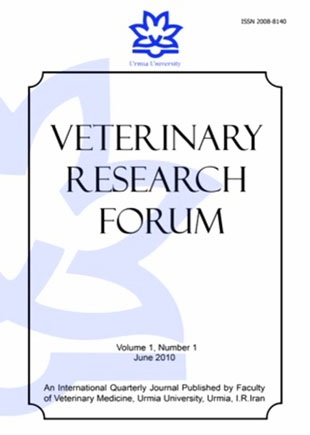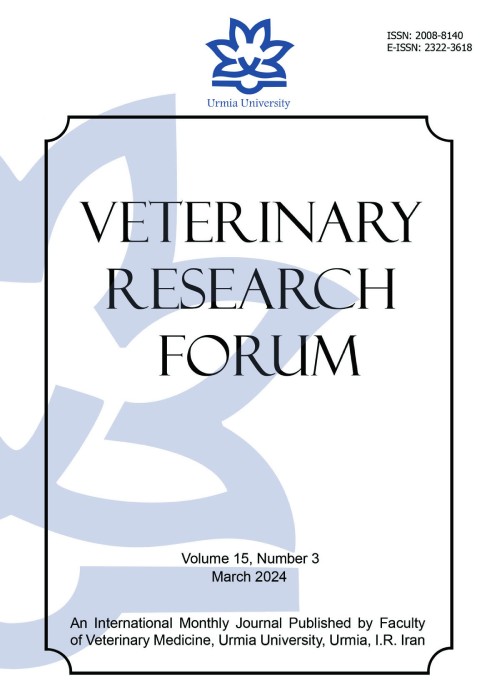فهرست مطالب

Veterinary Research Forum
Volume:1 Issue: 1, Spring 2010
- تاریخ انتشار: 1389/04/05
- تعداد عناوین: 9
-
-
Pages 1-6In the present study, the effects of intracerebroventricular (ICV) administration of normal saline (control), histamine, mepyramine (a histamine H1-receptor antagonist) and ranitidine (a histamine H2-receptor antagonist) were investigated on the formalin-induced pain in rabbits. Subcutaneous (SC) injection of a formalin (100 µl, 5%) solution into the ventral surface of the right hind paw was performed, and the time durations spent licking and biting the injected paw were measured in 10 min blocks for 1 h. The SC injection of formalin produced a short-lasting (10 min) pain response. The ICV injection of histamine at doses of 25, 50 and 100 µg significantly (P < 0.05) decreased the time duration spent licking and biting the injected paw. Mepyramine and ranitidine, used alone produced no effects. The ICV pretreatments with mepyramine and ranitidine at the same dose of 200 µg significantly (P < 0.05) prevented histamine (100 µg, ICV)-induced antinociception. These results indicate that activation of brain histamine with ICV injection of exogenous histamine produces antinociception. Central histamine H1 and H2 receptors may be involved in the centrally administered histamine-induced antinociception in the formalin-induced pain in rabbits.Keywords: Brain, Histamine, Formalin, induced pain, Rabbits
-
Pages 7-11Rabbits are widely used as laboratory animals for experimental surgery. Anesthesia of rabbits may present complications unless the method is easy to apply and safe to use. In present study, effects of different dosages of vitamin C on thiopental sodium induced anesthesia in 25 male New Zealand white rabbits were studied. In the animals that had not received vitamin C treatment before thiopental sodium induced general anesthesia, return mean time of front limb pedal, corneal and ear pinch reflexes were 6.40 ± 1.67, 6.60 ± 2.96 and 8.00 ± 2.58 minutes, respectively. Pre-treatment of rabbits with 30 and 240 mg kg-1 (IV) of vitamin C followed by thiopental sodium 20 mg kg-1 (IV) resulted in significant (P < 0.05) increase in front limb pedal reflex return mean time to 13.00 ± 2.24 and ear pinch to 11.60 ± 4.16 minutes, respectively. There was also significant (P < 0.05) decrease in the heart rate following induction of anesthesia in the animals pre-treated with 30 and 90 mg kg-1 (IV) vitamin C and no change in the animals pre-treated with 240 mg kg-1 (IV) vitamin C. Serum analysis indicated a significant (P < 0.05) increase in blood glucose. These results suggest that premedication of rabbits with vitamin C despite potentiating of thiopental sodium anesthesia in rabbits is not dose dependent.Keywords: Vitamin C, Thiopental Sodium, General anesthesia, Glucose effect, Rabbit
-
Pages 12-20In order to determine calcium (Ca), magnesium (Mg) content and total antioxidant capacity (TAC) of seminal plasma in buffalo and to study their associations with the semen characteristics, 54 semen samples were collected from 10 buffalo bulls; semen quality was evaluated, seminal plasma was then harvested by centrifugation and its Ca and Mg content were estimated and its TAC determined. The Ca and Mg content of the seminal plasma (Mean ± SEM) were recorded as 22.36 ± 0.52 mg dl-1 and 11.94 ± 0.36 mg dl-1 respectively, while, its mean TAC value was 1.50 ± 0.02 mmol L-1. The mean Ca value was highly associated with sperm progressive motility, gross motility, viability (P = 0.000 for all), negatively with semen volume (P = 0.01), and with Mg and TAC values (P = 0.000 for both). The mean Mg values was highly associated with sperm progressive motility, gross motility and viability and seminal plasma Ca and TAC (P = 0.000 for all) and negatively associated with semen volume (P = 0.014). The mean TAC values was highly associated with sperm progressive motility, gross motility and viability and seminal plasma Ca and Mg (P = 0.000 for all). For further clarification of these associations, the data was categorized in three groups of excellent (Ex, >90% motile, n = 33), good (Go, 80-89% motile, n = 15) and moderate (Mo, <79% motile, n = 6) according to their percentage of sperm motility. The mean progressive motility in Ex group was 92.24 ± 0.51%, in Go group it was 81.66 ± 0.62 %, and in Mo group it was 71.66 ± 1.05 %. The mean Ca, Mg and TAC values were respectively recorded as 25.12 ± 0.29 mg dl-1, 13.78 ± 0.20 mg dl-1, and 1.57 ± 0.009 mmol L-1 in Ex, 18.74 ± 0.63 mg dl-1, 9.14 ± 0.33mg dl-1, and 1.42 ± 0.044 mmol L-1 in Go, and 17.34 ± 0.18 mg dl-1, 8.06 ± 0.25 mg dl-1, and 1.23± 0.05 mmol L-1 in Mo groups. The associations in groups are discussed. These results show that seminal plasma Ca and Mg content and TAC are associated with semen characteristics, and synergistically have an effect on motility and viability of the spermatozoa after ejaculation, which are important factors in semen fertility.Keywords: Buffalo, Seminal plasma, Macro, elements, TAC
-
Pages 21-25The aim of this study was to determine whether anesthesia consisting of sedation induced by intramuscular administration of xylazine-diazepam and lumbosacral analgesia induced by epidural administration of lidocaine and xylazine is satisfactory for castration and ovariohysterectomy in cats. Six adult (3 male and 3 female, 2.5 ± 0.5 years of age) cats (mean body weight ± SD, 2.2 ± 0.44 kg) were used in this study. Cats were sedated with xylazine (1-2 mg kg-1 IM) and diazepam (0.2 mg kg-1, IM) and 5 minutes later a 2% solution of lidocaine (0.5ml/4.5kg) and xylazine (1 mg kg-1) were administered into the lumbosacral epidural space. Open castration technique or ventral midline routine ovariohysterectomy were performed. Time to onset, duration and cranial spread of analgesia were recorded. Heart rate, respiratory rate and rectal temperature were recorded at time 0 (prior to epidural drugs administration) as a base line values and at 10, 20, 30, 45 and 60 minutes after the epidural administration. Onset time of analgesia was 4.0 ± 0.63 min (Mean ± SEM) and duration of analgesia was 89.5 ± 3.0 min (Mean ± SEM). However, surgical procedures were completed within 25-37 min. There were significant decrease in heart rate and rectal temperature values and significant increase in respiratory rate (P < 0.001). Intramuscular administration of xylazine-diazepam for sedation and epidural administration of lidocaine and xylazine for analgesia provided satisfactory analgesia for castration and ovariohysterectomy in cats. Utilizing epidural anesthetic technique with this combination is most useful for spaying surgery, especially when the surgical procedure can be completed in < 40 minutes.Keywords: Epidural, Lidocaine, Xylazine, Castration, Ovariohysterectomy, Cat
-
Pages 26-29Forty-one wild sheep (Ovis ammon orintalis) from Kabodan Island of National Park of Urmia Lake (North-West of Iran), were examined during a period of six months from October 2002 to March 2003, for helminthes and coccidian infection. The numbers of oocyst and eggs per gram of faeces (OPG & EPG) were determined by the centrifuge flotation technique using saturated sugar solution. The rate of infection for Strongylid form, Marshalagia, Trichuris eggs, and lung worm larvae were 8 (19.5%), 12 (29.5%), 17 (41.5%) and 14 (34.1%), respectively. Thirty-three (80.48%) of the examined wild animals were infected to one or more Eimeria species including E. parva, E. ahsata, E. ovinoidalis and E. faurei. This study suggested that the rate of parasitic infection in wild sheep were very low but it would seem that in unsuitable condition such as drought and starvation, parasitic infection can be cause a serious problem in wild sheep population.Keywords: Wild sheep, Eimeria, Coccidia, Urmia Lack, Iran
-
Pages 30-43Camel milk has an importance in the treatment of diabetes. It has been shown that the patients who drink camel milk daily, their need to insulin decrease. Therefore, this study aimed to investigate the effect of camel milk in comparison with insulin treatment in experimentally-induced diabetes. This study was carried out on forty male New Zealand rabbits, divided into four groups with ten rabbits in each. The first group G1 was considered as control non-diabetic group and received only normal saline solution. The other animals were injected intravenously with alloxan for induction of diabetes mellitus and then divided into three groups'' ten rabbits each as the follows: G2 considered as control diabetic and left untreated, G3 was considered as diabetic and treated with insulin, and G4 was considered as diabetic and received camel milk. At the end of the experiment (4 weeks), blood (whole blood & serum) and tissue samples (liver, kidney and pancreas) were collected from all the animals for analysis of: enzymatic SOD and catalase, non-enzymatic GSH antioxidant enzyme activities. Serum malondialdeyde, glucose, insulin and lipid profile also were analyzed. The results showed that the camel milk was effective in the treatment of diabetes in comparison to insulin treatment alone. In addition to its hypoglycemic effect, camel milk improved the diabetes-induced oxidative stress. The histopathological evaluations demonstrated that there was a regeneration in b cells and the islets of Langerhans among the pancreatic acini in rabbits receiving camel milk. Our findings suggested that the camel milk administration in case of insulin dependant diabetes mellitus might be recommended as an oral anti-diabetic remedy.Keywords: Camel milk, Oxidative stress, Diabetes mellitus, Rabbit
-
Pages 44-49It is of critical importance to understand the modalities of BLV presence in semen, especially with regard to artificial insemination (AI). Presence of bovine leukemia provirus was demonstrated in fresh and frozen semen samples by researchers. In this study paired blood and semen samples from 45 bulls were assessed for the presence of part of gag gene and antibodies to BLV in blood, semen and cell-free fraction of the semen (seminal plasma). Proviral DNA was detected in 5 out of 45 seminal plasma samples. PCR products were sequenced and submitted to gene bank. This data strongly suggested that seminal plasma of seropositive bulls can be positive in PCR.Keywords: Bovine leukosis provirus, Semen, Seminal plasma, gag gene, PCR.
-
Pages 50-53The thyroid structural changes in pregnant ewes and their fetuses were investigated. Out of 100 pairs of thyroid glands collected from ewes and their fetuses at the local municipal abattoir in Ahvaz city of Khuzestan province, multiple lesions were seen in 59% and 21% of the thyroid glands of ewes and fetuses, respectively. Histologically, ninety nine lesions in the ewes and twenty two lesions in the fetuses’ thyroid glands were noticed.Keywords: Ewes, Fetus, Thyroid, Pathology
-
Page 54


